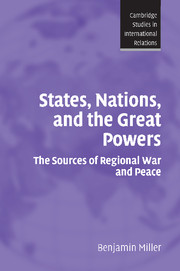Book contents
- Frontmatter
- Contents
- List of figures
- List of tables
- Preface and acknowledgments
- 1 Why some regions are peaceful and others are not
- 2 A theory of regional war and peace
- 3 States, nations, and war
- 4 Explaining the war proneness of the Middle East
- 5 The great powers war and peace in the Middle East
- 6 War and peace in the Balkans: states, nations, and great powers
- 7 The state-to-nation balance and the emergence of peace in South America during the twentieth century
- 8 The emergence of high-level peace in post-1945 Western Europe: nationalism, democracy, hegemony, and regional integration
- 9 Conclusions
- Appendix A Comparative dimensions of the state-to-nation imbalance in the Middle East, the Balkans, South America, and Western Europe in the post-1945 era
- Appendix B Data-file: major armed conflicts/wars by region, type, and modes of great power regional involvement (1945–2004)
- Bibliography
- Index
- Cambridge Studies in International Relations
1 - Why some regions are peaceful and others are not
Published online by Cambridge University Press: 22 September 2009
- Frontmatter
- Contents
- List of figures
- List of tables
- Preface and acknowledgments
- 1 Why some regions are peaceful and others are not
- 2 A theory of regional war and peace
- 3 States, nations, and war
- 4 Explaining the war proneness of the Middle East
- 5 The great powers war and peace in the Middle East
- 6 War and peace in the Balkans: states, nations, and great powers
- 7 The state-to-nation balance and the emergence of peace in South America during the twentieth century
- 8 The emergence of high-level peace in post-1945 Western Europe: nationalism, democracy, hegemony, and regional integration
- 9 Conclusions
- Appendix A Comparative dimensions of the state-to-nation imbalance in the Middle East, the Balkans, South America, and Western Europe in the post-1945 era
- Appendix B Data-file: major armed conflicts/wars by region, type, and modes of great power regional involvement (1945–2004)
- Bibliography
- Index
- Cambridge Studies in International Relations
Summary
This book offers a new theory of war and peace. I argue that if we approach the question of war and peace from the regional perspective, we may gain new insights which are otherwise obscured. The new theory developed here thus offers an explanation of the variations between war and peace within and among regions. It explains why some regions are particularly war-prone, while others are so peaceful that war among the regional states has become practically unthinkable. The theory also explains why regions become more or less war-prone over time.
The twentieth century was the stage on which two puzzling, not to say contradictory, phenomena were at play: some regions, such as the Middle East, were scenes of tense conflicts and numerous wars, while others, such as South America, suffered only a limited number of wars. During the very same period, however, Europe profoundly transformed itself from an unstable, war-prone region into a peaceful, stable one. South America's move toward peace began at the end of the nineteenth century, but it has not yet attained the depth and institutional overlay that now characterize the European regional peace.
Thus, in the contemporary international system, some regions are peaceful (Europe, the Americas), while other regions either experience recurrent bloody conflicts, or are constantly on the verge of descending into war (East Asia, South Asia, the Middle East, and, at least until recently, the Balkans).
- Type
- Chapter
- Information
- States, Nations, and the Great PowersThe Sources of Regional War and Peace, pp. 1 - 40Publisher: Cambridge University PressPrint publication year: 2007

